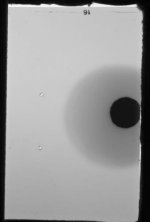Russell W. Barnes
Well-known
Not sure whether to post this here or in 'Film and Developing'.
When I've shot Fomapan or Rollei Retro 400 I've noticed that on the end of the film past the last shot, there's a black (fully exposed) dot about 10mm diameter on the neg. I've never seen it on Ilford or Kodak films and hitherto have assumed it to be a feature of the film, like the frame numbers on the rebates.
I've just shot a roll of Fomapan 400 Action through my Franka-Solida III and the black dot appears to have excessive light 'bleed-over', which has encroached onto the last frame edge. I also notice that one or two shots were fogged slightly at either the top edge or bottom edge of the shot, so somewhat inconsistent.
I admit to winding on in bright sunlight with the film number visible through the red window (little metal shutter open) and wondered if the sun would affect the film through this? I also observe that the red window in my Franka seems lighter than the red windows in my Baldixes, where it is very hard to read the numbers on Kodak and Ilford film compared to same film in my Franka.
Fomapan and Rollei numbers are easy to read, of course. Would sunlight through the red window be the cause of this fogging and the bleedover on the dot? I removed the film in a dark bag as I've had 'fat-film' issues with Fomapan in the past but ironically, not this time.
--
KInd Regds,
R.
When I've shot Fomapan or Rollei Retro 400 I've noticed that on the end of the film past the last shot, there's a black (fully exposed) dot about 10mm diameter on the neg. I've never seen it on Ilford or Kodak films and hitherto have assumed it to be a feature of the film, like the frame numbers on the rebates.
I've just shot a roll of Fomapan 400 Action through my Franka-Solida III and the black dot appears to have excessive light 'bleed-over', which has encroached onto the last frame edge. I also notice that one or two shots were fogged slightly at either the top edge or bottom edge of the shot, so somewhat inconsistent.
I admit to winding on in bright sunlight with the film number visible through the red window (little metal shutter open) and wondered if the sun would affect the film through this? I also observe that the red window in my Franka seems lighter than the red windows in my Baldixes, where it is very hard to read the numbers on Kodak and Ilford film compared to same film in my Franka.
Fomapan and Rollei numbers are easy to read, of course. Would sunlight through the red window be the cause of this fogging and the bleedover on the dot? I removed the film in a dark bag as I've had 'fat-film' issues with Fomapan in the past but ironically, not this time.
--
KInd Regds,
R.



